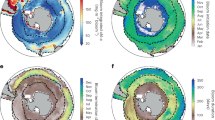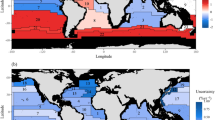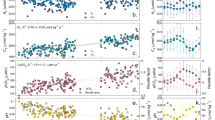Abstract
Arising from D. G. Boyce, M. R. Lewis & B. Worm Nature 466, 591–596 (2010)10.1038/nature09268; Boyce et al. reply
Identifying major changes in global ecosystem properties is essential to improve our understanding of biological responses to climate forcing and exploitation. Recently, Boyce et al.1 reported an alarming, century-long decline in marine phytoplankton biomass of 1% per year, which would imply major changes in ocean circulation, ecosystem processes and biogeochemical cycling over the period and have significant implications for management of marine fisheries. Closer examination reveals that time-dependent changes in sampling methodology combined with a consistent bias in the relationship between in situ and transparency-derived chlorophyll (Chl) measurements generate a spurious trend in the synthesis of phytoplankton estimates used by Boyce et al.1. Our results indicate that much, if not all, of the century-long decline reported by Boyce et al.1 is attributable to this temporal sampling bias and not to a global decrease in phytoplankton biomass.
This is a preview of subscription content, access via your institution
Access options
Subscribe to this journal
Receive 51 print issues and online access
$199.00 per year
only $3.90 per issue
Buy this article
- Purchase on Springer Link
- Instant access to full article PDF
Prices may be subject to local taxes which are calculated during checkout


Similar content being viewed by others
References
Boyce, D. G., Lewis, M. R. & Worm, B. Global phytoplankton decline over the past century. Nature 466, 591–596 (2010)
Sathyendranath, S., Prieur, L. & Morel, A. A 3-component model of ocean color and its application to remote-sensing of phytoplankton pigments in coastal waters. Int. J. Remote Sens. 10, 1373–1394 (1989)
Morel, A. & Prieur, L. Analysis of variations in ocean color. Limnol. Oceanogr. 22, 709–722 (1977)
McClain, C. R. et al. Science quality SeaWiFS data for global biosphere research. Sea Technol. 39, 10–16 (1998)
Author information
Authors and Affiliations
Corresponding author
Ethics declarations
Competing interests
The authors declare no competing financial interests.
PowerPoint slides
Rights and permissions
About this article
Cite this article
Rykaczewski, R., Dunne, J. A measured look at ocean chlorophyll trends. Nature 472, E5–E6 (2011). https://doi.org/10.1038/nature09952
Received:
Accepted:
Published:
Issue Date:
DOI: https://doi.org/10.1038/nature09952
This article is cited by
-
Scientists’ warning to humanity: microorganisms and climate change
Nature Reviews Microbiology (2019)
-
Boyce et al. reply
Nature (2011)
Comments
By submitting a comment you agree to abide by our Terms and Community Guidelines. If you find something abusive or that does not comply with our terms or guidelines please flag it as inappropriate.



